英语七年级上册Unit6
- 格式:ppt
- 大小:2.36 MB
- 文档页数:38
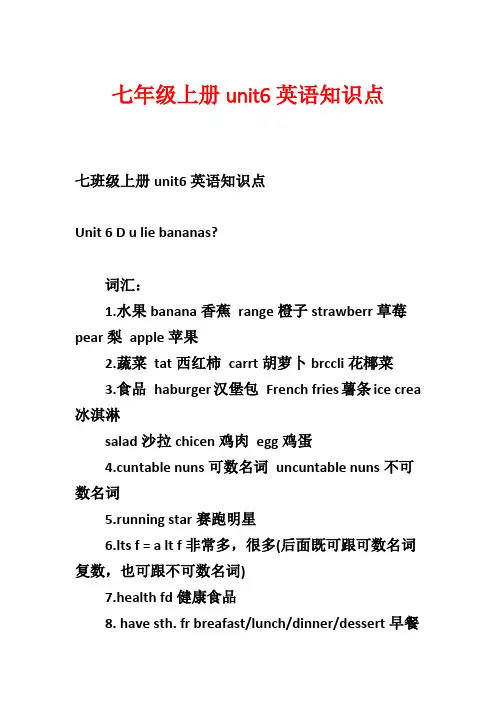
七年级上册unit6英语知识点七班级上册unit6英语知识点Unit 6 D u lie bananas?词汇:1.水果banana香蕉range橙子strawberr草莓pear梨apple苹果2.蔬菜tat西红柿carrt胡萝卜brccli花椰菜3.食品haburger汉堡包French fries薯条ice crea 冰淇淋salad沙拉chicen鸡肉egg鸡蛋4.cuntable nuns可数名词uncuntable nuns不可数名词5.running star赛跑明星6.lts f = a lt f非常多,很多(后面既可跟可数名词复数,也可跟不可数名词)7.health fd健康食品8. have sth. fr breafast/lunch/dinner/dessert早餐/中餐/晚餐/甜点吃……句型:D u lie salad? es, I d./N, I dn’t.Des he lie pears? es, he des./N, he desn’t.I lie ranges. I dn’t lie ranges.Running star eats lts f health fd.语法:句中谓语动词是实义动词的陈述句,变否定形式在实义动词前加dn’tdesn’t(主语是第三人称单数时用desn’t’).lie ding sth/lie t d sth 喜欢做某事I lie swiing. She lies t eat haburgers.句式:1.询问某人是否喜欢某物的`句型及答语—D/Des sb. lie sth.? —es,sb. d/des. —N,sb. dn’t/desn’t.—D u lie salad?—es,I d./ N,I dn’t.—Des he lie pears?—es,he des. / N,he desn’t.2.祈使句——Let’s d sth. Let’s have ice crea.3.一般现在时的肯定句及否定句I lie ranges. I dn’t lie bananas.The lie salad. The dn’t lie brccli.She lies bananas. She desn’t lie ice crea.。

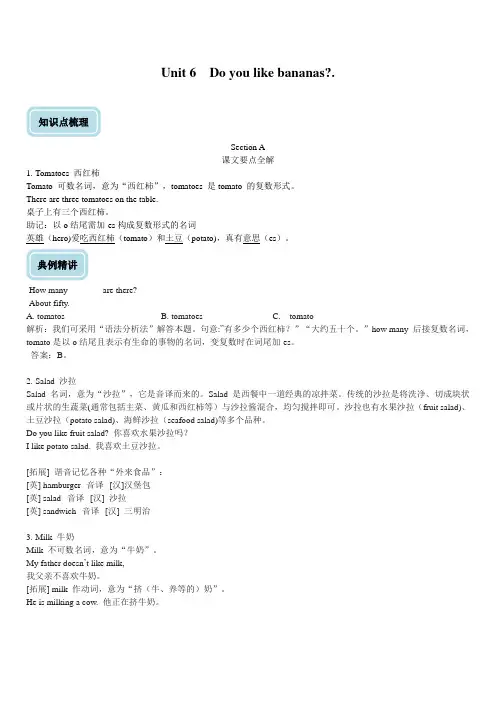
Unit 6 Do you like bananas?.知识点梳理Section A课文要点全解1.Tomatoes 西红柿Tomato 可数名词,意为“西红柿”,tomatoes 是tomato 的复数形式。
There are three tomatoes on the table.桌子上有三个西红柿。
助记:以o结尾需加-es构成复数形式的名词英雄(hero)爱吃西红柿(tomato)和土豆(potato),真有意思(es)。
典例精讲-How many________are there?-About fifty.A.tomatosB. tomatoesC. tomato解析:我们可采用“语法分析法”解答本题。
句意:”有多少个西红柿?”“大约五十个。
”how many 后接复数名词,tomato是以o结尾且表示有生命的事物的名词,变复数时在词尾加-es。
答案:B。
2.Salad 沙拉Salad 名词,意为“沙拉”,它是音译而来的。
Salad 是西餐中一道经典的凉拌菜。
传统的沙拉是将洗净、切成块状或片状的生蔬菜(通常包括主菜、黄瓜和西红柿等)与沙拉酱混合,均匀搅拌即可。
沙拉也有水果沙拉(fruit salad)、土豆沙拉(potato salad)、海鲜沙拉(seafood salad)等多个品种。
Do you like fruit salad? 你喜欢水果沙拉吗?I like potato salad. 我喜欢土豆沙拉。
[拓展] 谐音记忆各种“外来食品”:[英] hamburger--音译--[汉]汉堡包[英] salad--音译--[汉] 沙拉[英] sandwich--音译--[汉] 三明治k 牛奶Milk 不可数名词,意为“牛奶”。
My father doesn’t like milk,我父亲不喜欢牛奶。
[拓展] milk 作动词,意为“挤(牛、养等的)奶”。
He is milking a cow. 他正在挤牛奶。
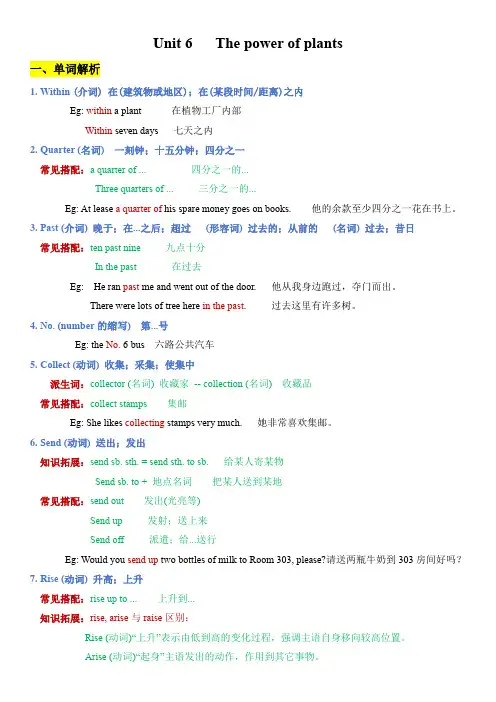
Unit 6 The power of plants一、单词解析1.Within (介词) 在(建筑物或地区);在(某段时间/距离)之内Eg: within a plant 在植物工厂内部Within seven days 七天之内2.Quarter (名词) 一刻钟;十五分钟;四分之一常见搭配:a quarter of ... 四分之一的...Three quarters of ... 三分之一的...Eg: At lease a quarter of his spare money goes on books. 他的余款至少四分之一花在书上。
3.Past (介词) 晚于;在...之后;超过(形容词) 过去的;从前的(名词) 过去;昔日常见搭配:ten past nine 九点十分In the past 在过去Eg: He ran past me and went out of the door. 他从我身边跑过,夺门而出。
There were lots of tree here in the past. 过去这里有许多树。
4.No. (number的缩写) 第...号Eg: the No. 6 bus 六路公共汽车5.Collect (动词) 收集;采集;使集中派生词:collector (名词) 收藏家-- collection (名词) 收藏品常见搭配:collect stamps 集邮Eg: She likes collecting stamps very much. 她非常喜欢集邮。
6.Send (动词) 送出;发出知识拓展:send sb. sth. = send sth. to sb. 给某人寄某物Send sb. to + 地点名词把某人送到某地常见搭配:send out 发出(光亮等)Send up 发射;送上来Send off 派遣;给...送行Eg: Would you send up two bottles of milk to Room 303, please?请送两瓶牛奶到303房间好吗?7.Rise (动词) 升高;上升常见搭配:rise up to ... 上升到...知识拓展:rise, arise与raise区别:Rise (动词)“上升”表示由低到高的变化过程,强调主语自身移向较高位置。
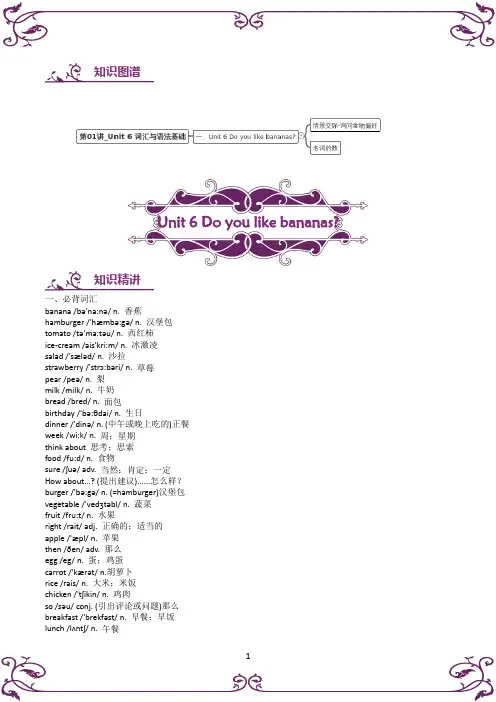
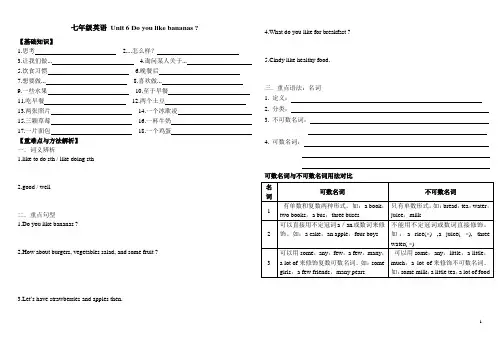
七年级英语Unit 6 Do you like bananas ?【基础知识】1.思考2....怎么样?3.让我们做...4.询问某人关于...5.饮食习惯6.晚餐后7.想要做... 8.喜欢做...9.一些水果10.至于早餐11.吃早餐12.两个土豆13.两张照片14.一个冰欺凌15.三颗草莓16.一杯牛奶17.一片面包18.一个鸡蛋【重难点与方法解析】一.词义辨析1.like to do sth / like doing sth2.good / well二.重点句型1.Do you like bananas ?2.How about burgers, vegetables salad, and some fruit ?3.Let’s have strawberries and apples then.4.What do you like for breakfast ?5.Cindy like healthy food.三.重点语法:名词1. 定义:2. 分类:3. 不可数名词:4. 可数名词:可数名词与不可数名词用法对比名词可数名词不可数名词1有单数和复数两种形式。
如:a book,two books,a bus,three buses只有单数形式。
如:bread,tea,water,juice,milk2可以直接用不定冠词a/an或数词来修饰。
如:a cake,an apple,four boys不能用不定冠词或数词直接修饰。
如:a rice(×) ,a juice( ×), threewater( ×)3可以用some,any,few,a few,many,a lot of来修饰复数可数名词。
如:somegirls,a few friends,many pears可以用some,any,little,a little,much,a lot of来修饰不可数名词。

人教版七年级上册英语Unit6 Do you like bananas一. 教材分析人教版七年级上册英语Unit6 Do you like bananas主要讲述了关于喜好和食物的话题。
本节课的主要内容是让学生能够用英语询问和描述他们对不同食物的喜好。
教材通过简单的对话和词汇,帮助学生掌握基本的交际用语,并能够运用这些句子进行日常交流。
此外,本单元还引入了一般现在时态的用法,让学生能够用英语描述他们的日常喜好和习惯。
二. 学情分析在进入七年级上册时,学生们已经掌握了基本的英语语法和词汇知识,具备一定的听、说、读、写的能力。
然而,对于一般现在时态的用法和复杂的句子结构,他们可能还较为陌生。
因此,在教学过程中,需要注重引导学生理解和运用一般现在时态,并通过大量的练习和实际操作,让他们能够熟练运用该时态进行描述和交流。
三. 说教学目标1.知识目标:学生能够掌握一般现在时态的用法,并能够用英语询问和描述他们对不同食物的喜好。
2.能力目标:学生能够听懂、说出一般现在时态的句子,并能够运用该时态进行日常交流。
3.情感目标:通过小组合作和互动交流,学生能够增强自信心,提高团队合作意识。
四. 说教学重难点1.教学重点:一般现在时态的用法和食物词汇的掌握。
2.教学难点:一般现在时态的运用和食物词汇的灵活运用。
五. 说教学方法与手段1.教学方法:采用任务型教学法,通过小组合作、互动交流和实际操作,引导学生主动参与学习过程。
2.教学手段:利用多媒体教学资源,如图片、音频和视频,增加学生的学习兴趣和参与度。
六. 说教学过程1.导入:通过展示一些常见食物图片,引导学生谈论他们对食物的喜好。
2.新课呈现:引入一般现在时态的概念,并通过示例句子让学生理解一般现在时态的用法。
3.对话练习:让学生听录音或观看视频,模仿对话中的句子,并进行角色扮演。
4.小组活动:学生分组进行讨论,用英语询问和描述他们对食物的喜好。
5.巩固练习:通过完成练习题和互动游戏,让学生进一步巩固一般现在时态的用法。
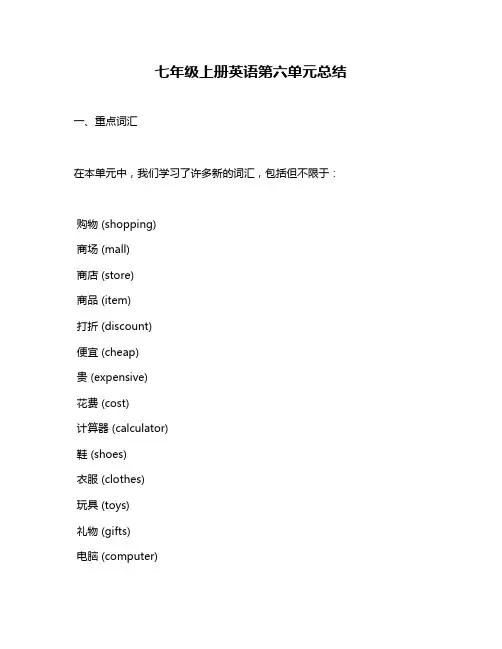
七年级上册英语第六单元总结一、重点词汇在本单元中,我们学习了许多新的词汇,包括但不限于:购物 (shopping)商场 (mall)商店 (store)商品 (item)打折 (discount)便宜 (cheap)贵 (expensive)花费 (cost)计算器 (calculator)鞋 (shoes)衣服 (clothes)玩具 (toys)礼物 (gifts)电脑 (computer)手机 (cellphone)电视 (TV)微波炉 (microwave)电饭煲 (rice cooker)二、主要句型在第六单元中,我们学习了以下主要的句型:1. "How much does it cost?" - "It costs $XX."2. "How much does it cost to buy a TV?" - "It costs $XX."3. "I need to buy a new pair of shoes." - "There are several stores in the mall that sell shoes."4. "This pair of shoes is too expensive." - "You might want to try another store."5. "I can't find the calculator I was looking for." - "You might want to try another store."6. "Do you have any discounts?" - "Yes, we do. XX% off for students."7. "Do you want to buy this pair of shoes?" - "Yes, I do." / "No, Idon't."8. "How much are these clothes?" - "They are $XX each."9. "I want to buy a gift for my friend." - "There are some nice toys in this store."10. "Do you want to come with me to the mall?" - "Yes, I do." / "No, I don't."三、语法重点在本单元中,我们重点学习了询问物品价格和进行购物对话的常用表达方式。

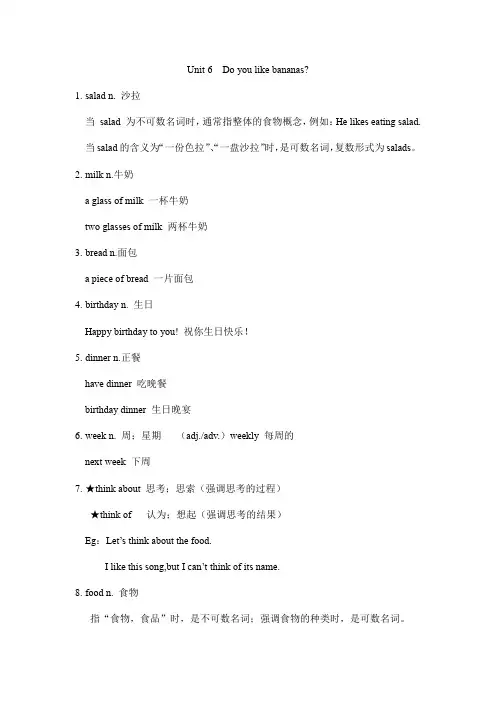
Unit 6 Do you like bananas?1.salad n. 沙拉当salad 为不可数名词时,通常指整体的食物概念,例如:He likes eating salad.“一盘沙拉”时,是可数名词,复数形式为salads。
当salad的含义为“一份色拉”、k n.牛奶a glass of milk 一杯牛奶two glasses of milk 两杯牛奶3.bread n.面包a piece of bread 一片面包4.birthday n. 生日Happy birthday to you! 祝你生日快乐!5.dinner n.正餐have dinner 吃晚餐birthday dinner 生日晚宴6.week n. 周;星期(adj./adv.)weekly 每周的next week 下周7.★think about 思考;思索(强调思考的过程)★think of 认为;想起(强调思考的结果)Eg:Let’s think about the food.I like this song,but I can’t think of its name.8.food n. 食物指“食物,食品”时,是不可数名词;强调食物的种类时,是可数名词。
9.right adj. 正确的;—(反义词)wrong 错误的adj. 右边的;—(反义词)left 左边的★All right!用作对方建议或劝告的应答语。
Eg:—Let’s go and ask him.让我们去问他。
—All right. 好的。
10.star n. 星星;明星a volleyball star 一个排球明星11.eat v. 吃★eating habits 饮食习惯12.well adv. 好;令人满意地(adj.)good 好的Eg:Sports Star Eats Well.I have good eating habits.13.question n. 问题one last qusetion 最后一个问题14.healthy adj. 健康的(n.)health 健康★keep healthy 保持健康15.want v. 想要want sth. 想要某物want to do sth. 想要做某事want sb. to do sth. 想要某人做某事Eg:I don’t want to be fat.16.—What do you like for breakfast?—I like ........【语法】名词的单复数有些名词既可作可数名词又可作不可数名词,但意义不同,要注意区分.①glass cn.杯子un.玻璃orange cn橘子un.橘汁①还有表示动物类的名词,表示动物时是可数名词,表示为菜肴时是不可数名词. chicken cn.小鸡un.鸡肉fish cn鱼un鱼肉①salad, icecream, food, fruit 作总称讲是不可数名词,作种类讲是可数名词【即学即练】一、请写出下列词的复数形式city _____ _zoo ______country _____ tooth ____mouse _________ boy____________ broom ___________car ____tree ______horse ______ bus______________ fox _____branch ____ baby _____ family _____ dish _____radio _____ photo _____ piano _____ knife _____leaf _____ life _____ thief _____ _man _____woman _____ child ___ foot______this _____________ watch___________ diary____________ day____________ book____________dress____________ sheep___________ tea_____________ box___________ strawberry_________ peach__________ sandwich__________ paper_________ juice__________ water____________ milk___________ rice__________people ______CD________ ox___________deer____________ fish___________二、选择填空.( )1. They e from different ______A. countryB. countriesC. a countryD. countrys( )2. How many ______ do you see in the picture?A. tomatosB. tomatoesC. tomatoD. the tomato( )3. They are______.A . woman teachers B. women teachersC. women teacherD. woman teacher( )4. Would you like _______ ,please?A. two glass of waterB. two glasses of waterC. two glass of watersD. two glasses of waters( )5. Most of ______ live in _______.A. Germans, GermanB. German, GermenC. Germen, GermanyD. Germans, Germany( )6. There are some ______ in these _______.A. knifes pencilboxesB. knives pencilsboxC. knives pencilboxD. knives pencilsboxes( )7. ______ like ______ by air.A. Greens, travellingB. The Green, travelingC. The Greens, travelD. The Greens, traveling( )8. I wonder why ______ are interested in action films(武打片).A. the peopleB. peopleC. peoplesD. the peoples( )9. There is no ______ in the plate.A. applesB. orangesC. riceD. eggs( )10.My uncle has three _______.A.childB.childsC.childrenD.childrens四.填入所给名词的正确形式。
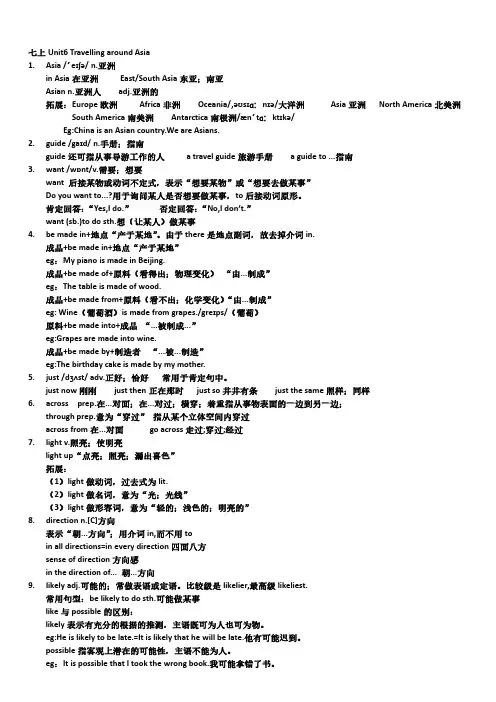
七上Unit6Travelling around Asia/´eɪʃə/n.亚洲in Asia在亚洲East/South Asia东亚;南亚Asian n.亚洲人adj.亚洲的拓展:Europe欧洲Africa非洲Oceania/,əʊsɪɑːnɪə/大洋洲Asia亚洲North America北美洲South America南美洲Antarctica南极洲/æn´tɑːktɪkə/Eg:China is an Asian country.We are Asians.2.guide/gaɪd/n.手册;指南guide还可指从事导游工作的人a travel guide旅游手册a guide to...指南3.want/wɒnt/v.需要;想要want后接某物或动词不定式,表示“想要某物”或“想要去做某事”Do you want to...?用于询问某人是否想要做某事,to后接动词原形。
肯定回答:“Yes,I do.”否定回答:“No,I don’t.”want(sb.)to do sth.想(让某人)做某事4.be made in+地点“产于某地”。
由于there是地点副词,故去掉介词in.成品+be made in+地点“产于某地”eg:My piano is made in Beijing.成品+be made of+原料(看得出;物理变化)“由...制成”eg:The table is made of wood.成品+be made from+原料(看不出;化学变化)“由...制成”eg:Wine(葡萄酒)is made from grapes./greɪps/(葡萄)原料+be made into+成品“...被制成...”eg:Grapes are made into wine.成品+be made by+制造者“...被...制造”eg:The birthday cake is made by my mother.5.just/dʒʌst/adv.正好;恰好常用于肯定句中。
七上英语第六单元知识点归纳
七年级上册英语第六单元主要涉及到一些日常生活中常见的话
题和知识点。
在这个单元中,学生将学习关于购物、衣服和颜色的
词汇和句子。
以下是对该单元知识点的归纳:
1. 购物,学习如何询问价格、购买衣物和付款的相关词汇和句子。
比如,“How much is this T-shirt?”(这件T恤多少钱?)
以及“Can I pay by credit card?”(我可以用信用卡支付吗?)。
2. 衣服,学习不同种类的衣物名称,比如T-shirt(T恤)、dress(连衣裙)、trousers(裤子)等,并学习描述衣物颜色和款
式的词汇和句子。
比如,“I like the blue dress.”(我喜欢那
件蓝色的连衣裙。
)。
3. 颜色,学习常见颜色的英文表达,比如red(红色)、
green(绿色)、blue(蓝色)等,以及如何用英语描述颜色。
此外,学生还会学习一些关于购物和衣物的对话和情景交际,
以便在实际生活中运用所学知识。
通过这些内容的学习,学生可以
扩展他们的词汇量,提高他们的口语表达能力,并且更好地理解和
运用日常生活中的英语知识。
总的来说,第六单元的重点是围绕购物、衣服和颜色展开,通过学习相关词汇和句子,帮助学生在日常生活中更加流利地运用英语进行交流和表达。
七年级上册英语unit6知识点归纳七年级上册英语Unit 6知识点归纳Unit 6的主题是“Where's my backpack?”,讲述了人物小明和小红在学校不小心把背包丢了,接着在学校寻找背包的过程中,学习到了一些有关位置的词汇和表达。
在这个单元中,我们学习了以下知识点:一、地点和位置的表达1. 在房间内例如:My bag is under the chair.(我的书包在椅子下面。
)The book is on the desk.(那本书在桌子上。
)2. 在建筑物内例如:The library is next to the gym.(图书馆在体育馆旁边。
)The restroom is opposite the classroom.(厕所在教室对面。
)3. 在城市内例如:The park is in the center of the city.(那个公园在城市中心。
)The mall is on Main Street.(商场在主街上。
)4. 其他位置例如:I'm in the front of the classroom.(我在教室前面。
)She is behind the tree.(她在树后面。
)二、问路和指路1. 问路例如:Excuse me, where is the restroom?(对不起,请问厕所在哪里?)Can you tell me how to get to the school library?(你可以告诉我怎样去学校图书馆吗?)2. 指路例如:Turn left at the corner.(在拐角处左转。
)Go straight ahead.(一直往前走。
)三、方位词1. 介词例如:The bank is across from the park.(银行在公园对面。
)The supermarket is between the post office and the bookstore.(超市在邮局和书店之间。
【2024秋季】最新人教版七年级上册英语第六单元Unit6《Day in the Life》课文翻译UNIT 6第六单元A Day in the Life一天的生活BIG Question How can you make good use of your time?大问题:你如何充分利用你的时间?In this unit, you will:在本单元中,你将:1. tell the time in English.用英语报时。
2. ask about daily routines using what time and when.用“几点”和“什么时候”询问日常作息。
3. learn about different people's routines.了解不同人的作息。
4. explore how to make good use of time.探讨如何充分利用时间。
Look and share:看并分享:1. What do you see in the photo?你在照片中看到了什么?2. How long do you study every day?你每天学习多长时间?3. What do you do every day?你每天做什么?SECTION AA节How do you spend your school day?你如何度过你的学校日?1a. Match the clocks with the times.1a. 将时钟与时间匹配。
one forty-five a quarter to two1:45 一点四十五分six fifteen. a quarter past six.6:15 六点十五分eight. eight o'clock.8:00 八点整four thirty. half past four4:30 四点半1b. Listen to the first conversation and tick Peter's activities this morning.1b. 听第一段对话并勾选Peter今天早上的活动。
初一上册英语第六单元七年级上Unit6英语同步单词和知识梳理Unit6 单词banana /b'nɑ:n/香蕉hamburger /'hmb:(r)ɡ(r)/汉堡包tomato /t'mɑ:t/西红柿ice-cream /,as'kri:m/冰激凌salad /'sld/沙拉strawberry /'str:ber/草莓pear /pe(r)/梨milk /mlk/牛奶bread /bred/面包birthday /'b:(r)θde/生日dinner /'dn(r)/(中午或晚上吃的)正餐week /wi:k/周;星期think about思考;思索food /fu:d/食物sure /(r)/当然;肯定;一定How about...?(提出建议)...怎么样?burger /'b:(r)ɡ(r)/汉堡包= hamburger vegetable /'vetbl/蔬菜fruit /fru:t/水果right /rat/正确的;适当的apple /'pl/苹果then /en/那么egg /eɡ/蛋;鸡蛋carrot /'krt/胡萝卜rice /ras/大米;米饭chicken /'kn/肌肉so /s/ (引出评论或问题)那么breakfast /'brekfst/早餐;早饭lunch /ln/午餐star /stɑ:(r)/明星;星星eat /i:t/吃well /wel/好;令人满意的habit /'hbt/习惯healthy /'helθi/健康的really /'ri:li/真正地question /'kwesn/问题want /wnt/需要;想要be /bi:/变成fat /ft/肥的;肥胖的Unit6 知识梳理Unit6 Do you like bananas?【重点短语】1. John ’s birthday dinner 约翰的生日宴会2. vegetable salad 蔬菜沙拉3. two tomatoes 两个西红柿4. eat well 吃得营养5. think about 考虑6. eat/have breakfast/lunch/dinner 吃早/午/晚饭7. sports stars 体育明星8. the volleyball star 排球明星9. ask sb. about sth. 问某人某事10. like hamburgers/ice-cream 喜欢汉堡包/冰淇淋11. like eating eggs 喜欢吃鸡蛋12. her eating habits 她的饮食习惯13. be (not) healthy (不)健康14. one last question 最后一个问题15. healthy food 健康食物16. after breakfast/lunch/dinner 早/午/晚饭后【重点句型】1.—Do you like salad? 你喜欢沙拉吗?一Yes,I do. /No, I don’t. 是的,我喜欢。
七年级上册英语Unit 6《Do you like bananas》知识点【重点词语】1. French fries 薯条2. ice cream 冰激凌3. running star 跑步明星4. lots of 许多,大量5. healthy food 健康食品6. unhealthy food 不健康食品7. make a list 列表,制表8. eat/have breakfast 吃早餐9. for breakfast 对于早餐来说【重难点分析】1. 可数名词和不可数名词(什么是可数名词,什么是不可数名词大家要会区分,这是学习语法的基础的基础)(1)可数名词:①定义:是可以计数的名词。
②可数名词前可以用a,an限定。
③可数名词前可以用one,two,three…限定。
④可数名词有复数形式。
(2)不可数名词:①定义:指不能计数的名词。
②不可数名词前不可以用a,an限定。
③不可数名词前不可以用one,two,three…限定。
④不可数名词没有复数形式。
2. 名词变复数的变换规则(对于变换复数的规则大家务必要掌握,这是比较重要的一个规则,如果实在不能掌握,我的个人建议是记住常见的一些名词的复数,这样也是可以应付考试的)(1)一般在名词词尾加-s.如:banana-bananas(2)以-o,-s,-sh,-ch及-x结尾的名词,在词尾加-es构成复数形式。
如:tomato-tomatoes(3)有些以-o结尾的名词仍加-s.如:photo-photos(4)以辅音字母加-y结尾的名词,把y去掉,加-ies.如:family-families(5)以-f或-fe结尾的名词,把f,fe去掉再加-ves.如:life-lives(6)有些名词以改变拼写来构成复数形式,即是不规则变化。
如:man-men(7)有些名词单、复数相同。
如:sheep-sheep3. lots of 大量的,许多的lots of在意思上与a lot of相同,都表示“大量、许多”,但lots of主要用于口语,两个都可以用来修饰可数名词和不可数名词,如:I haven't got a lot of time. 我们的时间不多了。
Unit 6: A school trip1. Introduction1.1 The importance of school tripsSchool trips are an important part of a student's learning experience. They provide students with the opportunity to learn outside of the classroom, explore new places, and g本人n practical knowledge thatplements their in-class learning.2. Unit 6: A school trip2.1 Lesson objectivesIn this unit, students will learn vocabulary related to travel and sightseeing. They will also practice using the present continuous tense to describe activities happening in the present.2.2 Lesson contentThe lesson begins with a reading passage about a school trip to Manchester. The passage introduces students to the present continuous tense and includes vocabulary related to travel and sightseeing. After reading the passage, students will answerprehension questions and engage in discussion about their own experiences with school trips.3. Reading passage: A school trip to Manchester3.1 The school tripThe students of St. Mary's School set off on a school trip to Manchester. They are excited as they board the bus and head off on the adventure.3.2 Sightseeing in ManchesterThe students visit some of Manchester's famous landmarks, including the Old Trafford stadium and the Museum of Science and Industry. They are amazed by the city's rich history and vibrant culture.3.3 Experiencing the present continuous tenseThe passage uses the present continuous tense to describe the activities happening during the school trip. For example, "The students are marveling at the fascinating exhibits in the museum" and "Some students are taking photos of the beautiful architecture in the city."4. Lesson activities4.1 Comprehension questionsAfter reading the passage, students will answerprehension questions to test their understanding of the text.4.2 DiscussionStudents will discuss their own experiences with school trips. They will talk about the places they have visited and the activities they have enjoyed during their trips.5. Vocabulary and grammar practice5.1 VocabularyStudents will learn new vocabulary related to travel and sightseeing, such as "landmark," "exhibit," and "architecture."5.2 GrammarStudents will practice using the present continuous tense to describe activities happening in the present. They will form sentences like "We are visiting the museum" and "The students are exploring the city."6. Conclusion6.1 Importance of the lessonUnit 6 provides students with the opportunity to learn and practice using the present continuous tense in a real-world context. It also exposes them to new vocabulary related to travel and sightseeing.6.2 ReflectionThe lesson encourages students to reflect on their own experiences and appreciate the value of school trips in broadening their knowledge and perspective.In conclusion, Unit 6: A school trip in the seventh-grade English textbook serves as an excellent resource for students to learn and practice the present continuous tense and expand their vocabulary related to travel and sightseeing. The reading passage about a school trip to Manchester engages students with a real-life scenario while providing valuable language input. Additionally, the lesson activities, includingprehension questions and discussions, allow students to apply their learning in a meaningful way and reflect on their own experiences with school trips. Overall, the unit contributes to aprehensive and immersive learning experience for students, 本人ding in their language development and cultural understanding.。